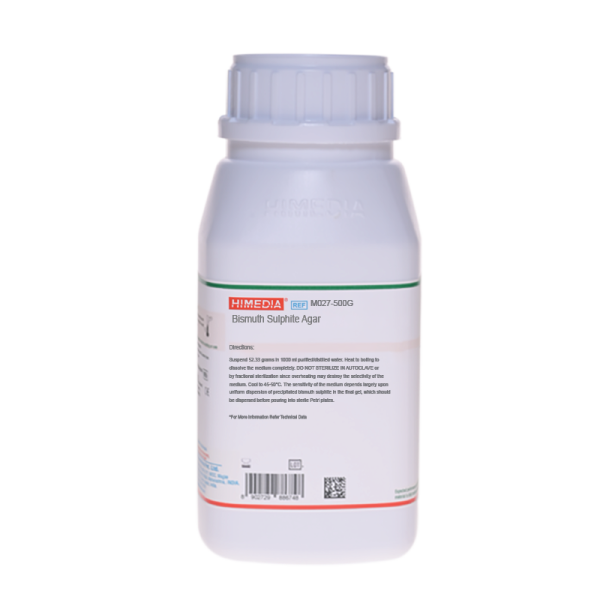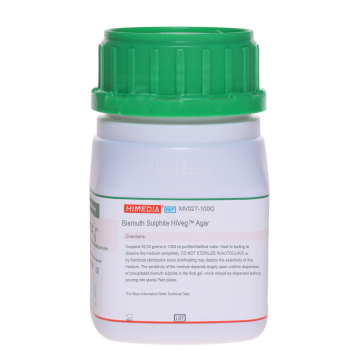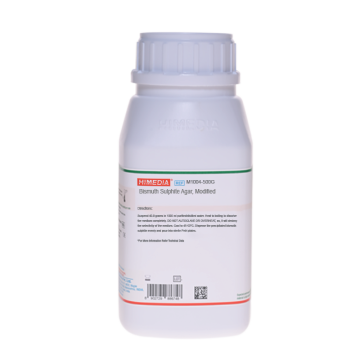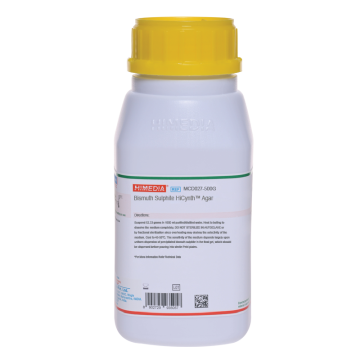 Your enquiry has been submitted
Your enquiry has been submitted
Bismuth Sulphite Agar
Intended Use
Recommended for the selective isolation of Salmonella from faeces, urine, sewage and other materials. The composition and performance criteria of this medium are as per specifications laid down in ISO 6579-1:2017.
Composition
ISO 6579-1 Specification -Bismuth Sulphite Agar
| Ingredients | g/L |
|---|---|
| Enzymatic digest of animal tissues Meat | 10.000 |
| extract | 5.000 |
| Dextrose | 5.000 |
| Disodium hydrogen phosphate, anhydrous | 4.000 |
| Ferrous sulphate, anhydrous | 0.300 |
| Bismuth sulphite indicator | 8.000 |
| Brilliant green | 0.025 |
| Agar | 20.000 |
Final pH (at 25°C): 7.7±0.2
Bismuth Sulphite Agar
| (BS) Ingredients | g/L |
|---|---|
| Peptone # | 10.000 |
| HM extract ## | 5.000 |
| Dextrose (Glucose) | 5.000 |
| Disodium hydrogen phosphate, anhydrous | 4.000 |
| Ferrous sulphate, anhydrous | 0.300 |
| Bismuth sulphite indicator | 8.000 |
| Brilliant green | 0.025 |
| Agar | 20.000 |
Final pH (at 25°C): 7.7±0.2
**Formula adjusted, standardized to suit performance parameters
# - Equivalent to Enzymatic digest of animal tissues ##-Equivalent to Meat extract
Directions
Suspend 52.33 grams in 1000 ml purified/distilled water. Heat to boiling to dissolve the medium completely. DO NOT STERILIZE IN AUTOCLAVE or by fractional sterilization since overheating may destroy the selectivity of the medium. The sensitivity of the medium depends largely upon uniform dispersion of precipitated bismuth sulphite in the final gel, which should be dispersed before pouring into sterile Petri plates.
Principle And Interpretation
The Salmonellae constitute the most taxonomically complex group of bacteria amongEnterobacteriaceae (1). Human Salmonella infections are most commonly caused by ingestion of food, water or milk contaminated by human or animal excreta. Humans are the only reservoirs of S. Typhi (2). Of the various media employed for the isolation and preliminary identification of Salmonellae, particularly Salmonella Typhi; Bismuth Sulphite Agar is the most productive. Bismuth Sulphite Agar is a modification of original Wilson and Blair Medium (3-5). It is also recommended by various Associations (2,6-8) for the isolation and preliminary identification of Salmonella Typhi and other Salmonellae from pathological materials, sewage, water, food and other products. Bismuth Sulphite Agar (M0271) is recommended for selective isolation and enumeration of Salmonella species in accordance with ISO Committee (8). S. Typhi, S. Enteritidis and S.Typhimurium typically grow as black colonies with or without a surrounding metallic sheen resulting from hydrogen sulphide production and reduction of sulphite to black ferric sulphide. Salmonella Paratyphi A grows as light green colonies. Bismuth Sulphite Agar may be inhibitory to some strains of Salmonella species and therefore should not be used as the sole selective medium for these organisms. Also this medium favors use of larger inoculum as compared to other selective media, as it has unique inhibitory action towards gram-positive organisms and coliforms.
Peptone and HM extract serve as sources as carbon, nitrogen, long chain amino acids, vitamins and essential growth factors. Dextrose is the carbon source. Disodium phosphate maintains the osmotic equilibrium. Bismuth sulphite indicator along with brilliant green inhibits the intestinal gram-positive and gram-negative bacteria. Ferrous sulphate aids in detection of hydrogen sulphide production. In case of food samples, pre-enrichment of the sample is done prior to inoculation.
Type of specimen
Clinical samples- faeces, Food and meat samples. milk and milk products, animal feed, animal faeces, environmental samples.
Specimen Collection and Handling
Processesing: (8)
Pre-enrichment: Samples (25 grams in 225 ml) are pre-enriched in Buffered Peptone Water (M14941) and incubated at 34°C to 38°C for 18 h ± 2 hours.
Selective enrichment
0.1 ml of pre- enriched sample is inoculated in 10 ml RVS Broth (M14481) or MSRV Agar (M1428) and incubated at 41.5 ± 1°C for 24 ± 3 hours and 1 ml of culture is inoculated in MKTT broth (M1496I) and incubated at 37° 1°C for 24 ± 3 hours. In-case of Salmonella Typhi and Salmonella Paratyphi A selective enrichment is carried out in Selenite Cystine broth and then incubated at 37± 1°C for 24 h ± 3 h and 48 h ± 3 h.
Isolation
The culture thus obtained is then plated on Bismuth Sulphite Agar (BS) (M027) and incubated at 37± 1°C for 24 ± 3 hours. An additional incubation of 24 ± 3 hours is recommended. Simultaneously plating on isolation agar XLD Agar, Modified (M0311) is carried out.
Confirmation
Biochemical and serological tests are performed for confirmation.
For clinical samples follow appropriate techniques for handling specimens as per established guidelines (7,9).
Warning and Precautions
In Vitro diagnostic use. For professional use only. Read the label before opening the container. Wear protective gloves/protective clothing/eye protection/face protection. Follow good microbiological lab practices while handling specimens and culture. Standard precautions as per established guidelines should be followed while handling specimens. Safety guidelines may be referred in individual safety data sheets.
Limitations
- DO NOT AUTOCLAVE OR OVERHEAT THE MEDIUM, as it destroys the selectivity of the medium.
- S. Typhi and S. Arizonae exhibit typical brown colonies, with or without metallic sheen.
- This medium is highly selective and must be used in parallel with less selective media for isolation.
- With certain Salmonella species, typical black colonies with metallic sheen is observed near heavy inoculation and isolated colonies may show green colonies.
- Individual organisms differ in their growth requirement and may show variable growth patterns on the medium.
Performance and Evaluation
Performance of the medium is expected when used as per the direction on the label within the expiry period when stored at recommended temperature.
Quality Control
Appearance
Light yellow to greenish yellow homogeneous free flowing powder.
Gelling
Firm, comparable with 2.0% agar gel.
Colour and Clarity of prepared medium
Greenish yellow coloured, opalescent with flocculent precipitate forms in Petri plates.
Reaction
Reaction of 5.23% w/v aqueous solution at 25°C. pH: 7.7±0.2.
pH
7.50-7.90
Cultural Response
Cultural response was observed after an incubation at 37 ± 1°C for 24 ± 3 hours. The plates are further incubated for an additional 24 ± 3 hours. Recovery rate is considered as 100% for bacteria growth on Soyabean Casein Digest Agar.
| Organism | Inoculum (CFU) | Growth | Recovery | Colour of Colony |
|---|---|---|---|---|
| Productivity | ||||
| Salmonella Typhimurium ATCC 14028 (00031*) | 50-100 | good | >=50% | Brown, grey or black colonies usually with a metallic sheen after 24 hours becoming uniformly black after 48 hours. |
| Salmonella Enteritidis ATCC 13076 (00030*) | 50-100 | good | >=50% | Brown, grey or black colonies usually with a metallic sheen after 24 hours becoming uniformly black after 48 hours. |
| Selectivity & Specificity | ||||
| Escherichia coli ATCC 8739 (00012*) | >=104 | growth or partial inhibition | Dull green or brown colonies without metallic sheen | |
| Escherichia coli ATCC 25922 (00013*) | >=104 | growth or partial inhibition | Dull green or brown colonies without metallic sheen | |
Selectivity
| Organism | Inoculum (CFU) | Growth | Recovery | Colour of Colony |
|---|---|---|---|---|
| Enterococcus faecalis ATCC 29212 (00087*) | >=104 | inhibited | 0 % | - |
| Enterococcus faecalis ATCC 19433 (00009*) | >=104 | inhibited | 0 % | - |
Additional testing |
||||
| Salmonella Typhi ATCC 6539 | 50-100 | good | >=50% | Brown, grey or black colonies usually with a metallic sheen after 24 hours becoming uniformly black after 48 hours. |
| Salmonella Paratyphi A ATCC 9150 | 50-100 | good | >=50% | Brown, grey or black colonies usually with a metallic sheen after 24 hours becoming uniformly black after 48 hours. |
Key: *Corresponding WDCM numbers.
Storage and Shelf Life
Store between 10-30°C in a tightly closed container and the prepared medium at 20-30°C. Use before expiry date on the label. On opening, product should be properly stored dry, after tightly capping the bottle in order to prevent lump formation due to the hygroscopic nature of the product. Improper storage of the product may lead to lump formation. Store in dry ventilated area protected from extremes of temperature and sources of ignition Seal the container tightly after use. Product performance is best if used within stated expiry period.
Disposal
User must ensure safe disposal by autoclaving and/or incineration of used or unusable preparations of this product. Follow established laboratory procedures in disposing of infectious materials and material that comes into contact with sample must be decontaminated and disposed of in accordance with current laboratory techniques (7, 9).
Reference
- Tindall B. J., Crimont P. A. D., Gorrity G. M., EUZESY B. P., 2005, Int. J. Sys. Evol. Microbiol., 55:521.
- Lipps WC, Braun-Howland EB, Baxter TE, eds. Standard methods for the Examination of Water and Wastewater, 24th ed. Washington DC:APHA Press; 2023.
- Wilson and Blair, 1926, J. Pathol. Bateriol., 29:310.
- Wilson and Blair, 1927, J. Hyg., 26:374.
- Wilson and Blair, 1931, J. Hyg., 31:138.
- FDA Bacteriological Analytical Manual, 2005, 18th Ed., AOAC, Washington, D.C.
- Jorgensen, J.H., Pfaller, M.A., Carroll, K.C., Funke, G., Landry, M.L., Richter, S.S and Warnock., D.W. (2015) Manual of Clinical Microbiology, 11th Edition. Vol. 1.
- Microbiobiology of the food chain- Horizontal method for the detection, enumeration and serotyping of Salmonella- Part I Detection of Salmonella. International Organization for Standardization (ISO), ISO/ DIS 6579-1:2017.
- Isenberg, H.D. Clinical Microbiology Procedures Handbook. 2nd Edition.
| Product Name | Bismuth Sulphite Agar |
|---|---|
| SKU | M027 |
| Product Type | Regular |
| Physical Form | Powder |
| Origin | Animal |
| Packaging type | HDPE |
| References | 1. Tindall B. J., Crimont P. A. D., Gorrity G. M., EUZESY B. P., 2005, Int. J. Sys. Evol. Microbiol., 55:521 2.Koneman E. W., Allen S. D., Janda W. M., Schreckenberger P. C., Winn W. C. Jr., 1992, Colour Atlas and Textbook ofDiagnostic Microbiology, 4 th Ed., J. B. Lippinccott Company 3.Mandell G. L., Douglas R. G. Jr., Bennet J. E., (Eds.) , 1985, Principles and Practice of Infectious Diseases, 2nd Ed., 660-669,John Wiley & Sons New York. 4.Gunter and Tuft, 1939, J. Lab. Clin. Med., 24:461. 5.Wilson and Blair, 1926, J. Pathol. Bateriol., 29:310. 6.Wilson and Blair, 1927, J. Hyg., 26:374 9.Baird R.B., Eaton A.D., and Rice E.W., (Eds.), 2015, Standard Methods for the Examination of Water andWastewater, 23rd ed., APHA, Washington, D.C. 10.FDA Bacteriological Analytical Manual, 2005, 18th Ed., AOAC, Washington, D.C. 11. Murray P. R., Baron J. H., Pfaller M. A., Tenover F. C. and Yolken R. H., (Eds.). 1999, Manual of Clinical Microbiology,7th Ed., American Society for Microbiology, Washington, D.C. 12.Salfinger Y., and Tortorello M.L. Fifth (Ed.), 2015, Compendium of Methods for the Microbiological Examination ofFoods, 5th Ed., American Public Health Association, Washington, D.C.1 3.Indian Pharmacopoeia, 1996, Ministry of Health and Family Welfare, Govt. of India, Volume 2.1 4.MacFaddin J. F., 2000, (Ed.), Biochemical Tests for Identification of Medical Bacteria, 3rd Edition, Lippincott, Williamss& Wilkins, New York.1 5.American Public Health Association, Standard Methods for the Examination of Dairy Products, 1978, 14th Ed.,Washington D.C.1 6.Isenberg, H.D. Clinical Microbiology Procedures Handb0ook. 2nd Edition.1 |
| Customized Product Available | No |










